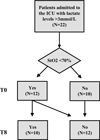Low tissue oxygen saturation at the end of early goal-directed therapy is associated with worse outcome in critically ill patients
- PMID: 19951385
- PMCID: PMC2786115
- DOI: 10.1186/cc8011
Low tissue oxygen saturation at the end of early goal-directed therapy is associated with worse outcome in critically ill patients
Abstract
Introduction: The prognostic value of continuous monitoring of tissue oxygen saturation (StO2) during early goal-directed therapy of critically ill patients has not been investigated. We conducted this prospective study to test the hypothesis that the persistence of low StO2 levels following intensive care admission is related to adverse outcome.
Methods: We followed 22 critically ill patients admitted with increased lactate levels (>3 mmol/l). Near-infrared spectroscopy (NIRS) was used to measure the thenar eminence StO2 and the rate of StO2 increase (RincStO2) after a vascular occlusion test. NIRS dynamic measurements were recorded at intensive care admission and each 2-hour interval during 8 hours of resuscitation. All repeated StO2 measurements were further compared with Sequential Organ Failure Assessment (SOFA), Acute Physiology and Chronic Health Evaluation (APACHE) II and hemodynamic physiological variables: heart rate (HR), mean arterial pressure (MAP), central venous oxygen saturation (ScvO2) and parameters of peripheral circulation (physical examination and peripheral flow index (PFI)).
Results: Twelve patients were admitted with low StO2 levels (StO2 <70%). The mean scores for SOFA and APACHE II scores were significantly higher in patients who persisted with low StO2 levels (n = 10) than in those who exhibited normal StO2 levels (n = 12) at 8 hours after the resuscitation period (P < 0.05; median (interquartile range): SOFA, 8 (7 to 11) vs. 5 (3 to 8); APACHE II, 32(24 to 33) vs. 19 (15 to 25)). There was no significant relationship between StO2 and mean global hemodynamic variables (HR, P = 0.26; MAP, P = 0.51; ScvO2, P = 0.11). However, there was a strong association between StO2 with clinical abnormalities of peripheral perfusion (P = 0.004), PFI (P = 0.005) and RincStO2 (P = 0.002). The persistence of low StO2 values was associated with a low percentage of lactate decrease (P < 0.05; median (interquartile range): 33% (12 to 43%) vs. 43% (30 to 54%)).
Conclusions: We found that patients who consistently exhibited low StO2 levels following an initial resuscitation had significantly worse organ failure than did patients with normal StO2 values, and found that StO2 changes had no relationship with global hemodynamic variables.
Figures


Similar articles
-
The relation of near-infrared spectroscopy with changes in peripheral circulation in critically ill patients.Crit Care Med. 2011 Jul;39(7):1649-54. doi: 10.1097/CCM.0b013e3182186675. Crit Care Med. 2011. PMID: 21685739
-
The temporal changes of tissue oxygen saturation (StO2) and central venous oxygen saturation (ScvO2) during sepsis/septic shock resuscitation.J Med Assoc Thai. 2014 Mar;97 Suppl 3:S168-75. J Med Assoc Thai. 2014. PMID: 24772595
-
Continuous muscle tissue oxygenation in critically injured patients: a prospective observational study.J Trauma. 2006 Oct;61(4):780-8; discussion 788-90. doi: 10.1097/01.ta.0000239500.71419.58. J Trauma. 2006. PMID: 17033541 Clinical Trial.
-
Skeletal muscle oxygen saturation (StO2) measured by near-infrared spectroscopy in the critically ill patients.Biomed Res Int. 2013;2013:502194. doi: 10.1155/2013/502194. Epub 2013 Aug 21. Biomed Res Int. 2013. PMID: 24027757 Free PMC article. Review.
-
Muscle StO2 in critically ill patients.Curr Opin Crit Care. 2008 Jun;14(3):361-6. doi: 10.1097/MCC.0b013e3282fad4e1. Curr Opin Crit Care. 2008. PMID: 18467900 Review.
Cited by
-
Tissue oxygen saturation as a goal, but when and where should we measure it?J Clin Monit Comput. 2013 Jun;27(3):211-3. doi: 10.1007/s10877-013-9438-5. Epub 2013 Feb 6. J Clin Monit Comput. 2013. PMID: 23385299 No abstract available.
-
Combination of Cv-aCO2/Ca-vO2 and Pv-aCO2 as markers of resuscitation or microcirculation in patients with septic shock: a pilot study.J Intensive Care. 2025 Jun 17;13(1):35. doi: 10.1186/s40560-025-00801-2. J Intensive Care. 2025. PMID: 40524226 Free PMC article.
-
StO₂ guided early resuscitation in subjects with severe sepsis or septic shock: a pilot randomised trial.J Clin Monit Comput. 2013 Jun;27(3):215-21. doi: 10.1007/s10877-013-9432-y. Epub 2013 Feb 5. J Clin Monit Comput. 2013. PMID: 23381608 Clinical Trial.
-
Near infrared spectroscopy (NIRS) of the thenar eminence in anesthesia and intensive care.Ann Intensive Care. 2012 May 8;2(1):11. doi: 10.1186/2110-5820-2-11. Ann Intensive Care. 2012. PMID: 22569165 Free PMC article.
-
Protocol for a multicentre retrospective observational cohort study in Denmark: association between the intraoperative peripheral perfusion index and postoperative morbidity and mortality in acute non-cardiac surgical patients.BMJ Open. 2019 Nov 21;9(11):e031249. doi: 10.1136/bmjopen-2019-031249. BMJ Open. 2019. PMID: 31753878 Free PMC article.
References
Publication types
MeSH terms
LinkOut - more resources
Full Text Sources

